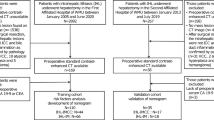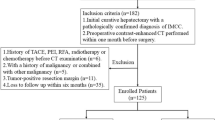Abstract
Objective
To establish a radiomics nomogram based on dynamic contrast-enhanced (DCE) MR images to preoperatively differentiate combined hepatocellular-cholangiocarcinoma (cHCC-CC) from mass-forming intrahepatic cholangiocarcinoma (IMCC).
Methods
A total of 151 training cohort patients (45 cHCC-CC and 106 IMCC) and 65 validation cohort patients (19 cHCC-CC and 46 IMCC) were enrolled. Findings of clinical characteristics and MR features were analyzed. Radiomics features were extracted from the DCE-MR images. A radiomics signature was built based on radiomics features by the least absolute shrinkage and selection operator algorithm. Univariate and multivariate analyses were used to identify the significant clinicoradiological variables and construct a clinical model. The radiomics signature and significant clinicoradiological variables were then incorporated into the radiomics nomogram by multivariate logistic regression analysis. Performance of the radiomics nomogram, radiomics signature, and clinical model was assessed by receiver operating characteristic and area under the curve (AUC) was compared.
Results
Eleven radiomics features were selected to develop the radiomics signature. The radiomics nomogram integrating the alpha fetoprotein, background liver disease (cirrhosis or chronic hepatitis), and radiomics signature showed favorable calibration and discrimination performance with an AUC value of 0.945 in training cohort and 0.897 in validation cohort. The AUCs for the radiomics signature and clinical model were 0.848 and 0.856 in training cohort and 0.792 and 0.809 in validation cohort, respectively. The radiomics nomogram outperformed both the radiomics signature and clinical model alone (p < 0.05).
Conclusion
The radiomics nomogram based on DCE-MRI may provide an effective and noninvasive tool to differentiate cHCC-CC from IMCC, which could help guide treatment strategies.
Key Points
• The radiomics signature based on dynamic contrast-enhanced magnetic resonance imaging is useful to preoperatively differentiate cHCC-CC from IMCC.
• The radiomics nomogram showed the best performance in both training and validation cohorts for differentiating cHCC-CC from IMCC.





Similar content being viewed by others
Abbreviations
- ADC:
-
Apparent diffusion coefficient
- AFP:
-
Alpha fetoprotein
- AP:
-
Arterial phase
- AUC:
-
Area under curve
- CA19-9:
-
Cancer antigen 19-9
- CHCC-CC:
-
Combined hepatocellular-cholangiocarcinoma
- CT:
-
Computed tomography
- DP:
-
Delayed phase
- HCC:
-
Hepatocellular carcinoma
- ICC:
-
Intrahepatic cholangiocarcinoma
- IMCC:
-
Mass-forming intrahepatic cholangiocarcinoma
- LASSO:
-
Least absolute shrinkage and selection operator
- MRI:
-
Magnetic resonance imaging
- PP:
-
Portal phase
- ROC:
-
Receiver operating characteristic curve
References
Ogasawara S, Akiba J, Nakayama M, Nakashima O, Torimura T, Yano H (2015) Epithelial cell adhesion molecule-positive human hepatic neoplastic cells: development of combined hepatocellular-cholangiocarcinoma in mice. J Gastroenterol Hepatol 30:413–420
BeaufrèeaufrrCalderaro J, Paradis V (2021) Combined hepatocellular-cholangiocarcinoma: An update. J Hepatol 74:1212–1224
Weber SM, Ribero D, O'Reilly EM, Kokudo N, Miyazaki M, Pawlik TM (2015) Intrahepatic cholangiocarcinoma: expert consensus statement. HPB (Oxford) 17:669–680
Bergquist A, von Seth E (2015) Epidemiology of cholangiocarcinoma. Best Pract Res Clin Gastroenterol 29:221–232
Sempoux C, Jibara G, Ward SC et al (2011) Intrahepatic cholangiocarcinoma: new insights in pathology. Semin Liver Dis 31:49–60
Tang Y, Wang L, Teng F, Zhang T, Zhao Y, Chen Z (2021) The clinical characteristics and prognostic factors of combined hepatocellular carcinoma and cholangiocarcinoma, hepatocellular carcinoma and intrahepatic cholangiocarcinoma after surgical resection: a propensity score matching analysis. Int J Med Sci 18:187–198
Machairas N, Stamopoulos P, Kostakis ID et al (2019) Mixed hepatocellular cholangiocarcinoma: a review of long-term outcomes following liver transplantation. Transplant Proc 51:437–439
Hori M, Murakami T, Kim T, Tomoda K, Nakamura H (2004) CT scan and MRI in the differentiation of liver tumors. Dig Dis 22:39–55
Donato H, França M, Candelária I, Caseiro-Alves F (2017) Liver MRI: from basic protocol to advanced techniques. Eur J Radiol 93:30–39
Wang Y, Yang Q, Li S, Luo R, Mao S, Shen J (2019) Imaging features of combined hepatocellular and cholangiocarcinoma compared with those of hepatocellular carcinoma and intrahepatic cholangiocellular carcinoma in a Chinese population. Clin Radiol 74:407.e401–407.e410
Nishie A, Yoshimitsu K, Asayama Y et al (2005) Detection of combined hepatocellular and cholangiocarcinomas on enhanced CT: comparison with histologic findings. AJR Am J Roentgenol 184:1157–1162
Thian YL, Riddell AM, Koh DM (2013) Liver-specific agents for contrast-enhanced MRI: role in oncological imaging. Cancer Imaging 13:567–579
Reimer P, Schneider G, Schima W (2004) Hepatobiliary contrast agents for contrast-enhanced MRI of the liver: properties, clinical development and applications. Eur Radiol 14:559–578
Hwang J, Kim YK, Park MJ et al (2012) Differentiating combined hepatocellular and cholangiocarcinoma from mass-forming intrahepatic cholangiocarcinoma using gadoxetic acid-enhanced MRI. J Magn Reson Imaging 36:881–889
Wee A (2011) Fine needle aspiration biopsy of hepatocellular carcinoma and hepatocellular nodular lesions: role, controversies and approach to diagnosis. Cytopathology 22:287–305
Yip SS, Aerts HJ (2016) Applications and limitations of radiomics. Phys Med Biol 61:R150–R166
Wei J, Jiang H, Gu D et al (2020) Radiomics in liver diseases: current progress and future opportunities. Liver Int 40:2050–2063
Mokrane FZ, Lu L, Vavasseur A et al (2020) Radiomics machine-learning signature for diagnosis of hepatocellular carcinoma in cirrhotic patients with indeterminate liver nodules. Eur Radiol 30:558–570
Li J, Xue F, Xu X, Wang Q, Zhang X (2020) Dynamic contrast-enhanced MRI differentiates hepatocellular carcinoma from hepatic metastasis of rectal cancer by extracting pharmacokinetic parameters and radiomic features. Exp Ther Med 20:3643–3652
Wu J, Liu A, Cui J, Chen A, Song Q, Xie L (2019) Radiomics-based classification of hepatocellular carcinoma and hepatic haemangioma on precontrast magnetic resonance images. BMC Med Imaging 19:23
Potretzke TA, Tan BR, Doyle MB, Brunt EM, Heiken JP, Fowler KJ (2016) Imaging features of biphenotypic primary liver carcinoma (hepatocholangiocarcinoma) and the potential to mimic hepatocellular carcinoma: LI-RADS analysis of CT and MRI features in 61 cases. AJR Am J Roentgenol 207:25–31
Sammon J, Fischer S, Menezes R et al (2018) MRI features of combined hepatocellular-cholangiocarcinoma versus mass forming intrahepatic cholangiocarcinoma. Cancer Imaging 18:8
Fowler KJ, Sheybani A, Parker RA 3rd et al (2013) Combined hepatocellular and cholangiocarcinoma (biphenotypic) tumors: imaging features and diagnostic accuracy of contrast-enhanced CT and MRI. AJR Am J Roentgenol 201:332–339
Landis JR, Koch GG (1977) The measurement of observer agreement for categorical data. Biometrics 33:159–174
Zhou HF, Han YQ, Lu J et al (2019) Radiomics facilitates candidate selection for irradiation stents among patients with unresectable pancreatic cancer. Front Oncol 9:973
Tibshirani R (2011) Regression shrinkage and selection via the lasso: a retrospective. J R Stat Soc Series B Stat Methodol 73:273–282
Zhang J, Huang Z, Cao L et al (2020) Differentiation combined hepatocellular and cholangiocarcinoma from intrahepatic cholangiocarcinoma based on radiomics machine learning. Ann Transl Med 8:119
Liu X, Khalvati F, Namdar K et al (2021) Can machine learning radiomics provide pre-operative differentiation of combined hepatocellular cholangiocarcinoma from hepatocellular carcinoma and cholangiocarcinoma to inform optimal treatment planning? Eur Radiol 31:244–255
Shur JD, Doran SJ, Kumar S et al (2021) Radiomics in oncology: a practical guide. Radiographics 41:1717–1732
Limkin EJ, Reuzé S, Carré A (2019) The complexity of tumor shape, spiculatedness, correlates with tumor radiomic shape features. Sci Rep 9:4329
Yap FY, Varghese BA, Cen SY et al (2021) Shape and texture-based radiomics signature on CT effectively discriminates benign from malignant renal masses. Eur Radiol 31:1011–1021
Cuocolo R, Stanzione A, Ponsiglione A et al (2019) Clinically significant prostate cancer detection on MRI: a radiomic shape features study. Eur J Radiol 116:144–149
Mechee MS, Hussain ZM, Salman ZI (2021) Wavelet theory: applications of the wavelet. Wavelet Theory
Liang W, Xu L, Yang P et al (2018) Novel nomogram for preoperative prediction of early recurrence in intrahepatic cholangiocarcinoma. Front Oncol 8:360
Zhou Y, Zhou G, Zhang J, Xu C, Wang X, Xu P (2021) Radiomics signature on dynamic contrast-enhanced MR images: a potential imaging biomarker for prediction of microvascular invasion in mass-forming intrahepatic cholangiocarcinoma. Eur Radiol 31:6846–6855
Kim TY, Cho NH, Jeong GB, Bengtsson E, Choi HK (2014) 3D texture analysis in renal cell carcinoma tissue image grading. Comput Math Methods Med 2014:536217
Tang TY, Li X, Zhang Q et al (2020) Development of a novel multiparametric MRI radiomic nomogram for preoperative evaluation of early recurrence in resectable pancreatic cancer. J Magn Reson Imaging 52:231–245
Yin X, Zhang BH, Qiu SJ et al (2012) Combined hepatocellular carcinoma and cholangiocarcinoma: clinical features, treatment modalities, and prognosis. Ann Surg Oncol 19:2869–2876
Kim SH, Park YN, Lim JH, Choi GH, Choi JS, Kim KS (2014) Characteristics of combined hepatocelluar-cholangiocarcinoma and comparison with intrahepatic cholangiocarcinoma. Eur J Surg Oncol 40:976–981
Funding
This study was supported by grants from the Shanghai Municipal Key Clinical Specialty (shslczdzk03202).
Author information
Authors and Affiliations
Corresponding authors
Ethics declarations
Guarantor
The scientific guarantor of this publication is Pengju Xu.
Conflict of interest
The authors declare no competing intrests.
Statistics and biometry
No complex statistical methods were necessary for this paper.
Informed consent
Written informed consent was waived by the Institutional Review Board.
Ethical approval
Institutional Review Board approval was obtained.
Methodology
• retrospective
• diagnostic or prognostic study
•performed at one institution
Additional information
Publisher’s note
Springer Nature remains neutral with regard to jurisdictional claims in published maps and institutional affiliations.
Supplementary information
ESM 1
(DOCX 166 kb)
Rights and permissions
About this article
Cite this article
Zhou, Y., Zhou, G., Zhang, J. et al. DCE-MRI based radiomics nomogram for preoperatively differentiating combined hepatocellular-cholangiocarcinoma from mass-forming intrahepatic cholangiocarcinoma. Eur Radiol 32, 5004–5015 (2022). https://doi.org/10.1007/s00330-022-08548-2
Received:
Revised:
Accepted:
Published:
Issue Date:
DOI: https://doi.org/10.1007/s00330-022-08548-2




